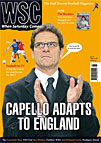 They showed the power of money in football but ultimately tripped up by planning poorly for the future, writes Michael Whalley
They showed the power of money in football but ultimately tripped up by planning poorly for the future, writes Michael Whalley
As football crash-and-burn stories go, it’s hard to beat the implosion of Colne Dynamoes nearly 20 years ago. In the late 1980s, the Dynamoes – bankrolled by millionaire chairman-manager Graham White – charged through the non-League pyramid on a budget to make some Football League clubs jealous. And then, in August 1990, having been denied promotion to the Conference because their ground wasn’t up to standard, they folded overnight.
That a town with a population of only 20,000 dreamed of hosting a Football League club may seem crazy now. But it’s a sign of how a corner of east Lancashire got carried away that, at one point, the club had genuine ambitions to match neighbours Burnley. “I think things got out of hand in the last couple of years,” says Phil Terry, who was the Dynamoes’ secretary from 1974 to 1990. “There were lads earning more money than they would have made playing in the Football League.”
White had founded the Dynamoes in 1963 as a team for a few old friends from Colne Primet High School. Starting out in the Nelson and Colne League, they bounced around the Lancashire amateur scene before becoming founder members of the North West Counties League in 1982. White, who had business interests in property and the timber industry, started to make his fortune in the mid-1980s, and began a spending spree on the Dynamoes that would eventually run into hundreds of thousands of pounds.
But it was only after they beat Emley at Wembley to win the FA Vase in 1988, the same year they clinched the North West Counties League title, that things got silly. He signed former Liverpool full-back Alan Kennedy and several other players on lucrative contracts as the Dynamoes ran away with the Northern Premier League First Division in 1989. That summer, White took the club full-time, even though they were still two levels below Division Four. Terry says: “We had eight or nine staff who had club cars. Graham paid Kevin Hird, the former Leeds and Burnley player, just to go round schools and talk to kids. We weren’t a big enough club to be doing stuff like that.”
But there was a bigger problem on the horizon. As Colne raced towards the Northern Premier title in 1989-90 in front of crowds averaging 1,300, it became clear that their Holt House ground wasn’t good enough for the Conference. White offered a reported £500,000 over two years to share with Burnley – a club he had tried to buy in early 1989. But the Turf Moor board were having none of it. He then unveiled plans for a new stadium on the outskirts of neighbouring Nelson, but they were never to become reality. “I think Graham buried his head in the sand a little bit,” Terry says. “The ground was something that should have been thought about at the beginning of that season, before he spent all that money.”
Colne walked away with the Northern Premier League title in 1990, but the door to the Conference was barred. The end, when it came, was sudden.
Terry recalls: “We played a pre-season friendly at Newcastle Blue Star a week before the first league game, and Graham told the players on the Monday morning afterwards that the club was folding. All of a sudden, those players had contracts that were worth nothing.”
White quit football, amid claims that he had received death threats (from who, it never became clear). In 18 years since, he has never spoken publicly about the Dynamoes’ collapse. Terry suggests that, quite simply, the money ran out. “There was talk of the players suing Graham through the PFA,” he says. “But if they had sued and won, I still don’t think they would have got any money – because there wasn’t any money.”
Six years after the Dynamoes folded, a new team – Colne FC – were formed. Managed by former Dynamoes player Nigel Coates, they sit comfortably in the North West Counties League. Last autumn, Colne FC revealed plans for a new stadium, to be built to Conference standards. Whatever the future for football in Colne, they want the stadium in place this time.
From WSC 255 May 2008